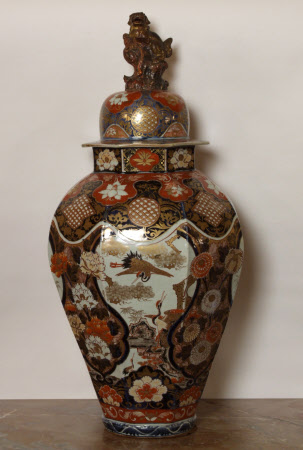Jar and cover
Category
Ceramics
Date
C. 1715 - 1735
Materials
Hard paste porcelain with underglaze cobalt blue and overglaze enamel and gilding.
Measurements
865 mm (H)370 mm (Diameter)
Place of origin
Arita
Order this imageCollection
Polesden Lacey, Surrey
NT 1245619
Summary
Pair of jars, hard paste porcelain, of octagonal baluster form with an upright rim, the domed lids with a wide horizontal rim and surmounted by a prominent knop (or finial) in the shape of a Buddhist lion (shishi in Japanese), made in Arita, Japan, c. 1715–35, decorated in the Imari style in underglaze blue, overglaze red enamel and gilding with cranes among trees surrounded by large lobed and pointed panels filled with stylised peonies and chrysanthemums and with circular and ‘pine-bark diamond’ (matsukawa-bishi) panels filled with overlapping circles.
Full description
Japanese porcelain densely decorated in blue, red and gold tended to be called ‘Imari’ in the West, after the port through which these wares were exported, even though they were actually made in and around the nearby town of Arita. The individual motifs derive from the Japanese decorative tradition, but the specific ways they were combined in the Imari manner and were applied to shapes such as these jars reflected Western taste and demand. In the early eighteenth century the appearance of Imari jars became particularly exuberant. Lions had an association with Buddhism in East Asia, as lion statues featured as guardians at the entrance to temples. They were added as a decorative feature to jars made for Western markets, where their original significance was not understood. Sets or ‘garnitures’ of Japanese and Chinese porcelain vases and jars were popular decorative features in Western interiors. (Emile de Bruijn, January 2024) References: Patricia F. Ferguson, Ceramics: 400 Years of British Collecting in 100 Masterpieces, Swindon, National Trust, 2019, pp. 70–1 (referring to similar jars dated to c. 1715–35 at Shugborough Hall and Erddig). Patricia F. Ferguson, Garnitures: Vase Sets from the National Trust, London, V&A Publishing, 2016.
Provenance
Bequeathed to the National Trust by Dame Margaret Greville, DBE (1863-1942).

